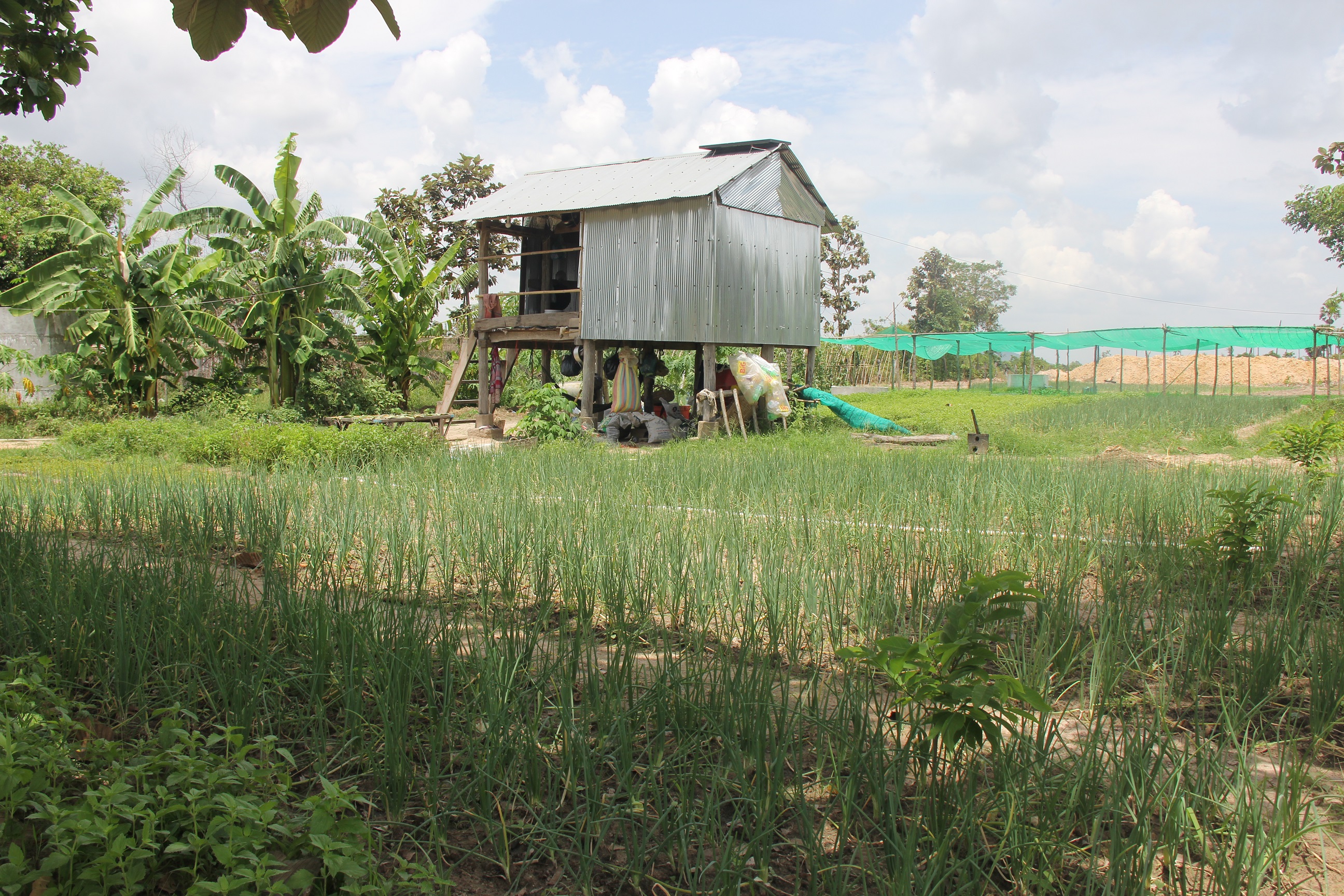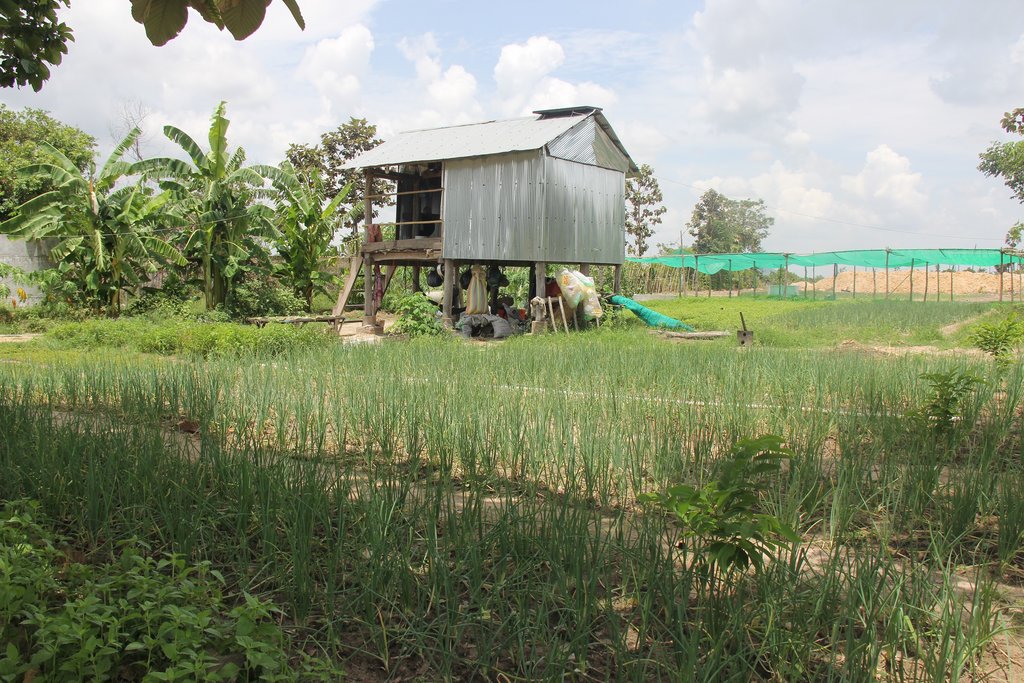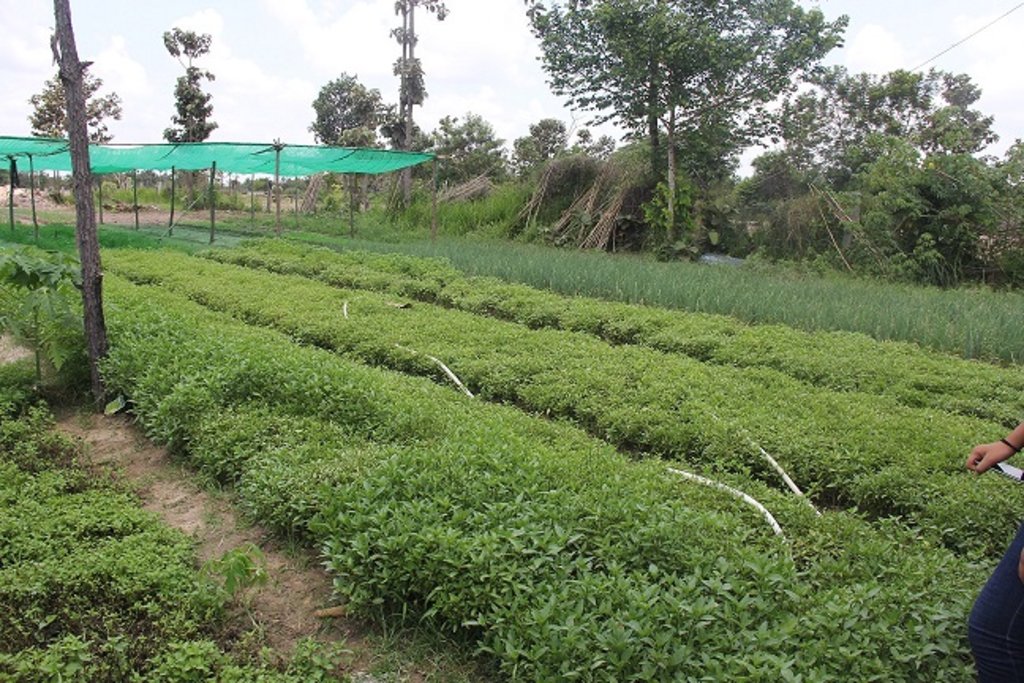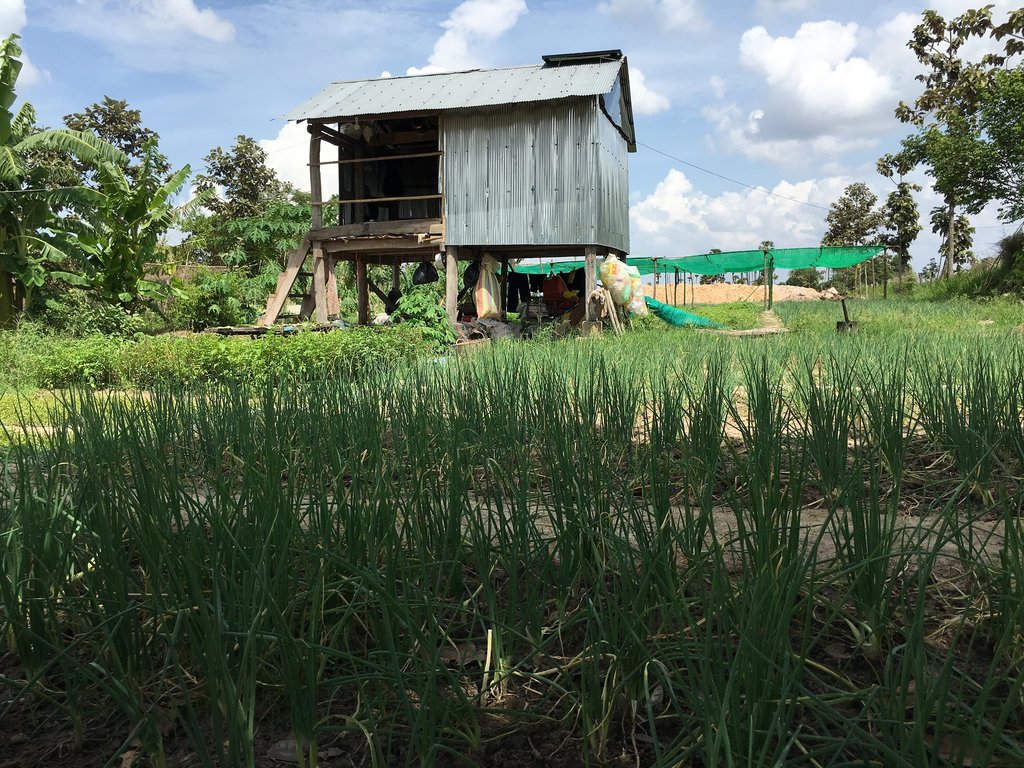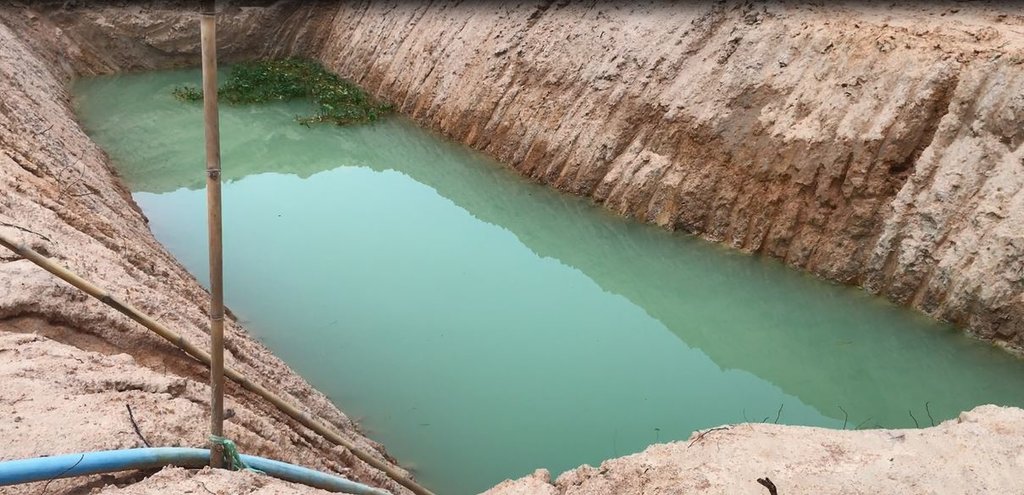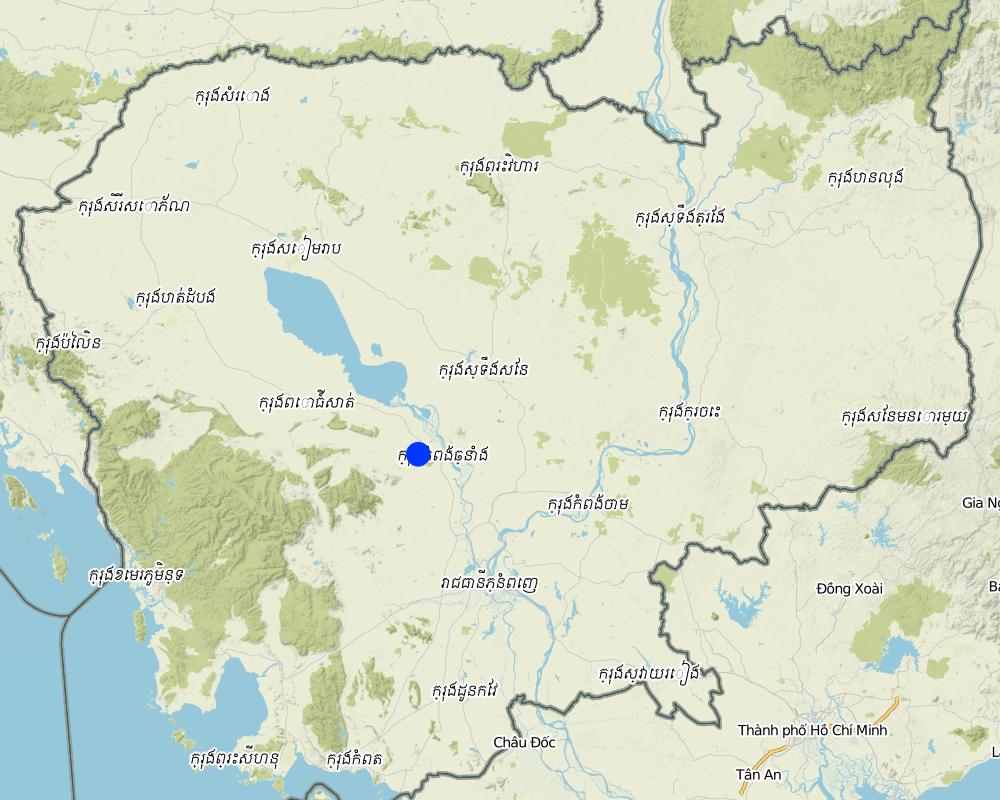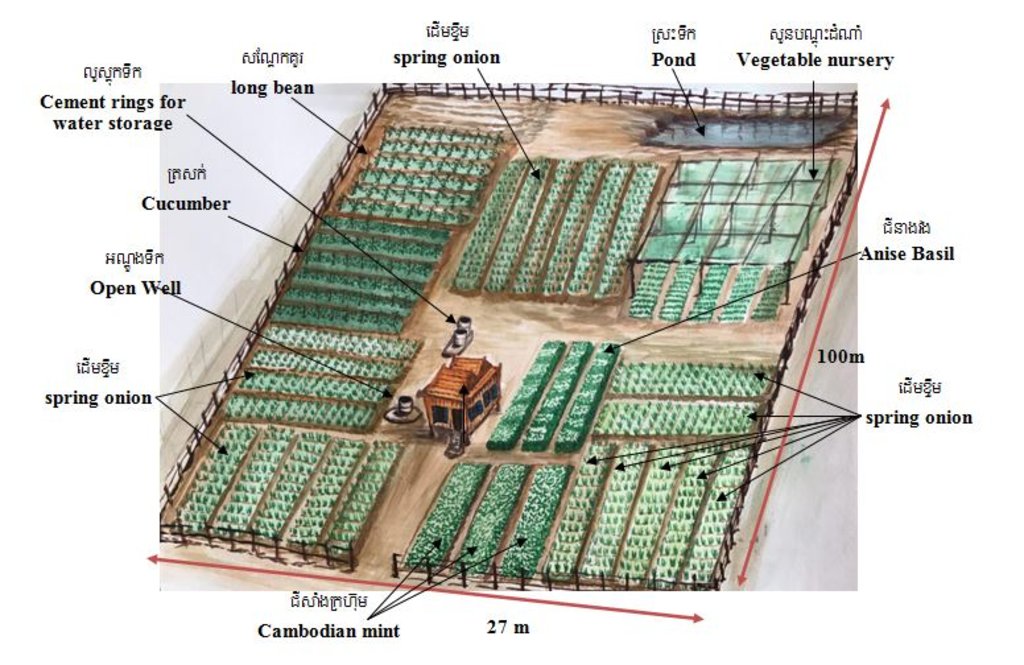Crop diversification with the application of rotation techniques [กัมพูชา]
- ผู้สร้างสรรค์:
- การอัพเดท:
- ผู้รวบรวม: Navin Chea
- ผู้เรียบเรียง: Sophea Tim, Sok Pheak
- ผู้ตรวจสอบ: Nimul CHUN, Ursula Gaemperli
Crop diversification farm
technologies_3145 - กัมพูชา
ดูส่วนย่อย
ขยายทั้งหมด ย่อทั้งหมด1. ข้อมูลทั่วไป
1.2 รายละเอียดที่ติดต่อได้ของผู้รวบรวมและองค์กรที่เกี่ยวข้องในการประเมินและการจัดเตรียมทำเอกสารของเทคโนโลยี
วิทยากรหลัก
ผู้ใช้ที่ดิน:
Phrum Thon
(+855) 95 211 223 / (+855) 69 40 6550
N/A
Land User
Ruessei Duoch village, Banteay Peal Commune, Rolea B'ier District, Kampong Chhnang Province.
กัมพูชา
Vice Chief of Agronomy Office at Agricultural Office of Rolea B'ier :
Chhim Bunleang
(+855) 77 797324
chhimbunleang@gmail.com
Agricultural Office of Rolea B'ier.
Prey Puoch village, Chrey Bak commune, Rolea B'ier district, Kampong Chhnange province.
กัมพูชา
Vice Chief of Agricultural Extension Office at Provincial Department of Agriculture, Forestry and Fisheries, Kampong Chhnang province:
Chief of Agricultural Office of Tuek Phos:
ชื่อของโครงการซึ่งอำนวยความสะดวกในการทำเอกสารหรือการประเมินเทคโนโลยี (ถ้าเกี่ยวข้อง)
Scaling-up SLM practices by smallholder farmers (IFAD)ชื่อขององค์กรซึ่งอำนวยความสะดวกในการทำเอกสารหรือการประเมินเทคโนโลยี (ถ้าเกี่ยวข้อง)
Royal University of Agriculture (RUA) - กัมพูชา1.3 เงื่อนไขการใช้ข้อมูลที่ได้บันทึกผ่านทาง WOCAT
วันที่เก็บรวบรวมข้อมูล(ภาคสนาม) :
22/05/2017
ผู้รวบรวมและวิทยากรหลักยอมรับเงื่อนไขเกี่ยวกับการใช้ข้อมูลที่ถูกบันทึกผ่านทาง WOCAT:
ใช่
1.4 การเปิดเผยเรื่องความยั่งยืนของเทคโนโลยีที่ได้อธิบายไว้
เทคโนโลยีที่ได้อธิบายไว้นี้เป็นปัญหาของความเสื่อมโทรมโทรมของที่ดินหรือไม่ จึงไม่ได้รับการยอมรับว่าเป็นเทคโนโลยีเพื่อการจัดการที่ดินอย่างยั่งยืน:
ไม่ใช่
2. การอธิบายลักษณะของเทคโนโลยี SLM
2.1 การอธิบายแบบสั้น ๆ ของเทคโนโลยี
คำจำกัดความของเทคโนโลยี:
Crop diversification is the practice of simultaneously cultivating two or multiple varieties of crops in a given area whilst at the same time applying crop rotation and/or intercropping. In this case study the land user has been practicing crop diversification with eleven different crop varieties.
2.2 การอธิบายแบบละเอียดของเทคโนโลยี
คำอธิบาย:
Crop diversification entails simultaneously growing two or multiple varieties of crops in a particular place with the application of crop rotation techniques and/or intercropping. The selection of the crop varieties will depend on the purpose of the land user. In general, a diversity of crops will provide a range of benefits such as food security, nutritional diversity, income generation, soil conservation, pest and disease control as well as adaptation to climate change (CGIAR, 2017, Makate et al, 2016, MoEYS& VVOB Cambodia, 2013).
Mrs. Prum Thon has been cultivating a diversity of crops with the application of rotation techniquesfor about 10 years, which involves exchanging an entire crop in a particular row. This means that cultivation can take place throughout the year without having to leave the land fallow. At the time of the interview eleven different crops had been cultivated including spring onions, anise basil, Cambodian mint, bok choy, choy sum, escarole, mint, long beans, cucumbers, bitter melons and lettuce. Almost all of these crops have an average lifespan of three months, except for the anise basil which can grow for one or two years depending on the way it is cultivated. After she has harvested a particular crop, she will then rotate this crop row with a new distinctive crop species. For instance after having harvested spring onions she will then plant mint in that row, and in the row where she was previously growing mint, she will rotate that with either spring onions or cucumbers.
The practice of crop diversification whilst at the same time rotating the crop in each of the rows aims to achieve the following main objectives:
Crop diversification enables the farmer to generate a daily income to offset her daily expenses which thereby becomes a means of improving her livelihood. Growing a diversity of crops can also enable her to meet a variety of market demands and generate a high daily income. If a farmer grows only one crop specie she can usually earn about 15,000 Riel per day, but if she plants four crop species such as anise basil, bok choy, long beans and cucumbers she can increase her income to about 20,000 Riel per day, However if she grows one more specie such as lettuce or grows eleven different crops, she would be able to increase her income up to 40,000 or 80,000 Riel per day. The practice of crop diversification enables her to generate an income on a daily basis.
Crop diversification with the rotation of the crop in each row after the harvest could assist in reducing soil degradation. According to her experience and observations each crop absorbs different nutrients from the soil. If one row is repeatedly used to cultivate spring onions, they tend not to flourish so well and the roots have a tendency to decay. However if they are rotated with another crop and the spring onions are then grown in another row, they are able to thrive and the roots and stems are less likely to spoil. Crop diversification also has other functions as the cover crops help to reduce soil degradation through expose to sunlight, maintain soil moisture, make the soil less compact and add beneficial micro-organisms to the soil. In addition crop diversification can control pests especially the practice of growing companion plants such as herbs or spring onions as this can prevent crops from being damaged by pests.
The use of this technology assists in improving livelihoods, reduces migration because she does not need to move in order to find a job in another location, and enables her to generate a daily income. In addition this technology is able to reduce the risk of crop failure resulting from damage by pests and insects.Furthermore it reduces the risks associated with changes in market demand as the farmer produces a diversity of crops and also it prevents and reduces soil degradation. In order to effectively use this technology there needs to be sufficient water supply such as a river, stream, well or pond.This enables the land user to grow crops throughout the year round and reduces damage of crops as the result of unpredictable adverse climate conditions such as changes in rainfall, or the occurrence of drought.
2.3 รูปภาพของเทคโนโลยี
2.5 ประเทศภูมิภาค หรือสถานที่ตั้งที่เทคโนโลยีได้นำไปใช้และได้รับการครอบคลุมโดยการประเมินนี้
ประเทศ:
กัมพูชา
ภูมิภาค/รัฐ/จังหวัด:
Ruessei Duoch village, Banteay Peal Commune, Rolea B'ier District, Kampong Chhnang Province.
Map
×2.6 วันที่การดำเนินการ
ถ้าไม่รู้ปีที่แน่นอน ให้ระบุวันที่โดยประมาณ:
- 10-50 ปี
2.7 คำแนะนำของเทคโนโลยี
ให้ระบุว่าเทคโนโลยีถูกแนะนำเข้ามาอย่างไร:
- ด้วยการริเริ่มของผู้ใช้ที่ดินเอง
- ในช่วงการทดลองหรือการทำวิจัย
- ทางโครงการหรือจากภายนอก
ความคิดเห็น (ประเภทของโครงการ เป็นต้น) :
Through her experience and training from Cambodian Center for Study and Development in Agriculture (CEDAC).
3. การจัดประเภทของเทคโนโลยี SLM
3.1 วัตถุประสงค์หลักของเทคโนโลยี
- ปรับปรุงการผลิตให้ดีขึ้น
- ลด ป้องกัน ฟื้นฟู การเสื่อมโทรมของที่ดิน
- สร้างผลกระทบทางด้านเศรษฐกิจที่เป็นประโยชน์
3.2 ประเภทของการใช้ที่ดินในปัจจุบันที่ได้นำเทคโนโลยีไปใช้

พื้นที่ปลูกพืช
- การปลูกพืชล้มลุกอายุปีเดียว
พืชหลัก (พืชเศรษฐกิจและพืชอาหาร):
Spring onion, anise basil, Cambodian mint, bok choy, escarole, choy sum, mint, long bean, cucumber, bitter melon, lettuce.
ถ้าการใช้ที่ดินมีการเปลี่ยนแปลงเนื่องมาจากการนำเทคโนโลยีไปปฏิบัติใช้ ให้ระบุการใช้ที่ดินก่อนนำเทคโนโลยีไปปฏิบัติใช้:
Degraded forest land.
3.3 ข้อมูลเพิ่มเติมเกี่ยวกับการใช้ที่ดิน
การใช้น้ำของที่ดินที่มีการใช้เทคโนโลยีอยู่:
- น้ำฝนร่วมกับการชลประทาน
แสดงความคิดเห็น:
There is one open well and a pond for crop irrigation during drought.
จำนวนของฤดูเพาะปลูกต่อปี:
- 3
ระบุ:
Crop rotation throughout the whole year. The land is alway coverd by corps (no fallow period).
3.4 กลุ่ม SLM ที่ตรงกับเทคโนโลยีนี้
- ระบบหมุนเวียน (การปลูกพืชหมุนเวียน การพักดิน การเกษตรแบบไร่เลื่อนลอย)
- การจัดการความอุดมสมบรูณ์ของดินแบบผสมผสาน
- การจัดการศัตรูพืชและโรคพืชแบบผสมผสาน (รวมถึงเกษตรอินทรีย์ด้วย)
3.5 กระจายตัวของเทคโนโลยี
ระบุการกระจายตัวของเทคโนโลยี:
- กระจายไปอย่างสม่ำเสมอในพื้นที่
ถ้าหากว่าเทคโนโลยีได้มีการกระจายออกไปอย่างสม่ำเสมอในพื้นที่ ให้ระบุปริมาณพื้นที่ที่ได้รับการครอบคลุมถึง:
- < 0.1 ตร.กม.(10 เฮกตาร์)
แสดงความคิดเห็น:
It is spread over an area of 2700 square meters.
3.6 มาตรการ SLM ที่ประกอบกันเป็นเทคโนโลยี

มาตรการจัดการพืช
- A1: พืช/สิ่งปกคลุมดิน
- A2: อินทรียวัตถุในดิน/ความอุดมสมบูรณ์ในดิน

มาตรการอนุรักษ์ด้วยโครงสร้าง
- S5: เขื่อน ชั้นดินที่แน่นแข็งบ่อน้ำ

มาตรการอื่น ๆ
แสดงความคิดเห็น:
The farmer grows specific companion plants on the same plot with the aim of improving the plant growth and the pest control.
3.7 รูปแบบหลักของการเสื่อมโทรมของที่ดินที่ได้รับการแก้ไขโดยเทคโนโลยี

การเสื่อมโทรมของดินทางด้านเคมี
- Cn (Fertility decline): ความอุดมสมบูรณ์และปริมาณอินทรียวัตถุในดินถูกทำให้ลดลงไป (ไม่ได้เกิดจากสาเหตุการกัดกร่อน)

การเสื่อมโทรมของดินทางด้านกายภาพ
- Pc (Compaction): การอัดแน่น

การเสื่อมโทรมของดินทางด้านชีวภาพ
- Bc (Reduction of vegetation cover): การลดลงของจำนวนพืชที่ปกคลุมดิน
- Bs (Quality and species composition): องค์ประกอบหรือความหลากหลายทางคุณภาพและชนิดพันธุ์ลดลง
- Bl (Loss of soil life): การสูญเสียสิ่งมีชีวิตในดิน
- Bp (Increase of pests/diseases): การเพิ่มขึ้นของศัตรูพืชและโรคพืช
3.8 การป้องกัน การลดลง หรือการฟื้นฟูความเสื่อมโทรมของที่ดิน
ระบุเป้าหมายของเทคโนโลยีกับความเสื่อมโทรมของที่ดิน:
- ป้องกันความเสื่อมโทรมของที่ดิน
- ลดความเสื่อมโทรมของดิน
แสดงความคิดเห็น:
At the first time when she cultivated the land the soil was fertile. At that time she grew only cassava but she realized soon that if she grows always the same crop, the soil will be less fertile from year to year.
4. ข้อมูลจำเพาะด้านเทคนิค กิจกรรมการนำไปปฏิบัติใช้ ปัจจัยนำเข้า และค่าใช้จ่าย
4.1 แบบแปลนทางเทคนิคของเทคโนโลยี
4.2 ข้อมูลจำเพาะด้านเทคนิคและการอธิบายแบบแปลนทางเทคนิค
The total area on which the technology has been applied amounts to 2700 square meters (27 meters x 100 meters). Each of the diverse crop species such as spring onions, anise basil, bok choy, choy sum, escarole, Cambodian mint, long beans, bitter melons and lettuce have been divided into separate blocks.
The spring onion crop has been divided into 5 blocks out of which the first block measures 8.50 m x 8.50 m = 72.25 square meters and it contains a total of five rows. The length of each row is 8.50 m and width is 1.4 m and space between each row is 4 centimeters. The second block measures 14.60 m x 13 m= 189.3 square meters and it has been divided into two rows. Each row is 14.60 m in length and has a width of 1.4 m with a space of 4cm between the two rows. The third block measures 9.60 m x 3.90 m= 37.44 square meters and it contains 6 rows. Each of the rows is 9.60 m x 1.4 m and the space between each of the rows is 4 cm. The fourth block measures 6.35 m x 4.55 m= 28.89 square meters and it is divided into 4 rows. Each of the rows is 6.35 m in length and 1.4 m in width, and the space between each of the rows is 4 cm. The fifth block measures 11.60 m x 14.70 m = 170.52 square meters and it contains 6 rows. Each of the rows is 11.60 m in length, and 1.5 m in width and the space between each of the rows is 4 cm.
The block in which the anise basil is grown is 14.60 meters in length and 1.4 meters in width with a 4 cm space between the 3 rows. The block of cucumbers is divided into 6 rows with the length of each row being 10 meters and the width being0.5 meters. Each row rises to a height of about 1.5 cm and within the row the space between each cucumber clump is 0.5 cm. In the block of the long beans there are 6 rows with each row being 10 meters in length and 0.5 meters in width. Additionally the height of each row is 1.5 cm and space between each clump of long beans is 2 cm.
The nursery containing escarole, choy sum and lettuce is 14.60 meters x 13.50 meters and its roof has a height of 2 meters. There are two cement rings which also have a cement base that have been constructed for water storage. Each cement ring is 1 meter in height and 1 meter in diameter. Furthermore there is also one open well and a pond which provide water for domestic supply and the irrigation of crops.
4.3 ข้อมูลทั่วไปเกี่ยวกับการคำนวณปัจจัยนำเข้าและค่าใช้จ่าย
ให้ระบุว่าค่าใช้จ่ายและปัจจัยนำเข้าได้รับการคำนวณอย่างไร:
- ต่อพื้นที่ที่ใช้เทคโนโลยี
ระบุขนาดและหน่วยพื้นที่:
2700 square meters
ถ้าใช้หน่วยพื้นที่ตามท้องถิ่น ให้ระบุตัวแปลงค่า เช่น 1 เฮกตาร์ :
อื่นๆ หรือสกุลเงินประจำชาติ (ระบุ):
KHR
ระบุอัตราแลกเปลี่ยนจากดอลลาร์สหรัฐเป็นสกุลเงินท้องถิ่น (ถ้าเกี่ยวข้อง) คือ 1 เหรียญสหรัฐ =:
4000.0
ระบุค่าเฉลี่ยของค่าจ้างในการจ้างแรงงานต่อวัน:
15000
4.4 กิจกรรมเพื่อการจัดตั้ง
| กิจกรรม | ประเภทของมาตรการ | ช่วงเวลาดำเนินการ | |
|---|---|---|---|
| 1. | Dig open well | ด้วยโครงสร้าง | During dry season |
| 2. | Dig pond | ด้วยโครงสร้าง | During dry season |
| 3. | Plough the soil two times and dry the soil by sunlight | จัดการพืช | After harvest |
| 4. | Buy crop seeds | จัดการพืช | At the beginning of soil preparation |
| 5. | Prepare pipe lines into cement rings | ด้วยโครงสร้าง | At the beginning of soil preparation |
| 6. | Buy net to cover the roof of the nursery house | มาตรการอื่น ๆ | At the beginning of soil preparation |
| 7. | Buy materials such as spit, handled basket, hoe ect | มาตรการอื่น ๆ | At the beginning of soil preparation |
4.5 ค่าใช้จ่ายของปัจจัยนำเข้าที่จำเป็นสำหรับการจัดตั้ง
| ปัจจัยนำเข้า | หน่วย | ปริมาณ | ค่าใช้จ่ายต่อหน่วย | ค่าใช้จ่ายทั้งหมดต่อปัจจัยนำเข้า | %ของค่าใช้จ่ายที่ก่อให้เกิดขึ้นโดยผู้ใช้ที่ดิน | |
|---|---|---|---|---|---|---|
| แรงงาน | Plough the soil for the first and second time | person-day | 11.0 | 15000.0 | 165000.0 | 100.0 |
| แรงงาน | Clear land for growing 11 different crops | person-day | 15.0 | 15000.0 | 225000.0 | 100.0 |
| แรงงาน | Dig the open well and put the cement ring | person-day | 84.0 | 15000.0 | 1260000.0 | 100.0 |
| แรงงาน | Dig pond | person-day | 133.0 | 15000.0 | 1995000.0 | 100.0 |
| อุปกรณ์ | Bamboo sticks | Piece | 50.0 | 1500.0 | 75000.0 | 100.0 |
| อุปกรณ์ | Hoe | Piece | 2.0 | 17000.0 | 34000.0 | 100.0 |
| อุปกรณ์ | Spit | Piece | 2.0 | 1300.0 | 2600.0 | 100.0 |
| อุปกรณ์ | Handle basket to carry soil | Pair | 1.0 | 6000.0 | 6000.0 | 100.0 |
| วัสดุด้านพืช | Spring onion | Kilogram | 10.0 | 1000.0 | 10000.0 | 100.0 |
| วัสดุด้านพืช | Bok choy | Can | 12.0 | 1500.0 | 18000.0 | 100.0 |
| วัสดุด้านพืช | Escarole | Package | 2.0 | 10000.0 | 20000.0 | 100.0 |
| วัสดุด้านพืช | Choy Sum | Can | 5.0 | 1500.0 | 7500.0 | 100.0 |
| วัสดุด้านพืช | Anise basile | Package | 1.0 | 15000.0 | 15000.0 | 100.0 |
| วัสดุด้านพืช | Mint | Kilogram | 3.0 | 4000.0 | 12000.0 | 100.0 |
| วัสดุด้านพืช | Cambodian mint | Kilogram | 2.0 | 2500.0 | 5000.0 | 100.0 |
| วัสดุด้านพืช | Long bean | Kilogram | 1.0 | 60000.0 | 60000.0 | 100.0 |
| ปุ๋ยและสารฆ่า/ยับยั้งการเจริญเติบโตของสิ่งมีชีวิต (ไบโอไซด์) | Buy cow manure for the use of one year | Two wheel handle tractor | 10.0 | 70000.0 | 700000.0 | 100.0 |
| ปุ๋ยและสารฆ่า/ยับยั้งการเจริญเติบโตของสิ่งมีชีวิต (ไบโอไซด์) | Buy chicken manure for the use of one year | Bag | 20.0 | 4000.0 | 80000.0 | 100.0 |
| ปุ๋ยและสารฆ่า/ยับยั้งการเจริญเติบโตของสิ่งมีชีวิต (ไบโอไซด์) | Buy soil of termite mounds | Two wheel handle tractor | 10.0 | 40000.0 | 400000.0 | 100.0 |
| ปุ๋ยและสารฆ่า/ยับยั้งการเจริญเติบโตของสิ่งมีชีวิต (ไบโอไซด์) | Buy botanical pesticides | Liter | 6.0 | 4000.0 | 24000.0 | 100.0 |
| ปุ๋ยและสารฆ่า/ยับยั้งการเจริญเติบโตของสิ่งมีชีวิต (ไบโอไซด์) | Rice husk | Bag | 30.0 | 1500.0 | 45000.0 | 100.0 |
| ปุ๋ยและสารฆ่า/ยับยั้งการเจริญเติบโตของสิ่งมีชีวิต (ไบโอไซด์) | Buy Bat manure for soil preparation | Bag | 5.0 | 70000.0 | 350000.0 | 100.0 |
| วัสดุสำหรับก่อสร้าง | Water Pumping Machine | Piece | 2.0 | 880000.0 | 1760000.0 | 100.0 |
| วัสดุสำหรับก่อสร้าง | Cement rings which also have a cement base that have been constructed for water storage to irrigate crops. | Piece | 2.0 | 70000.0 | 140000.0 | 100.0 |
| วัสดุสำหรับก่อสร้าง | Net for making the roof to prevent sunlight and water. | Set | 2.0 | 220000.0 | 440000.0 | 100.0 |
| อื่น ๆ | Cucumber | Can | 1.0 | 40000.0 | 40000.0 | 100.0 |
| อื่น ๆ | Lettuce | Package | 5.0 | 15000.0 | 75000.0 | 100.0 |
| อื่น ๆ | Bitter melon | Package | 2.0 | 5000.0 | 10000.0 | 100.0 |
| ค่าใช้จ่ายทั้งหมดของการจัดตั้งเทคโนโลยี | 7974100.0 | |||||
แสดงความคิดเห็น:
Generally, the rate for digging a pond in Cambodia is USD 50 per hour if the contractor does not obtain the soil, but if he does the cost of digging the pond will be less. Cost calculations of this technology are based on crop cycles (the average lifespan of crop being three months with a diversity of eleven crops). The farmer uses her own labor force to implement this technology without hiring any external labor. In reference to the costs indicated in the table above, there may be minor errors compared to the actual costs because the land user did not make exact records, and the costs that were provided are only estimates.
4.6 การบำรุงรักษาสภาพหรือกิจกรรมที่เกิดขึ้นเป็นประจำ
| กิจกรรม | ประเภทของมาตรการ | ช่วงระยะเวลา/ความถี่ | |
|---|---|---|---|
| 1. | Watering | จัดการพืช | Two times per day or three times per day depend on the weather. |
| 2. | Apply cow manure | จัดการพืช | When dig the soil near the crop root. |
| 3. | Apply bat manure | จัดการพืช | When dig the soil near the crop root. |
| 4. | Weeding | จัดการพืช | Once a week |
| 5. | Spraying pesticides | จัดการพืช | When there is insects. |
4.7 ค่าใช้จ่ายของปัจจัยนำเข้าและกิจกรรมที่เกิดขึ้นเป็นประจำที่ต้องการการบำรุงรักษา (ต่อปี)
| ปัจจัยนำเข้า | หน่วย | ปริมาณ | ค่าใช้จ่ายต่อหน่วย | ค่าใช้จ่ายทั้งหมดต่อปัจจัยนำเข้า | %ของค่าใช้จ่ายที่ก่อให้เกิดขึ้นโดยผู้ใช้ที่ดิน | |
|---|---|---|---|---|---|---|
| แรงงาน | When weeding, dig the soil near the crop root and apply fertilizer for elevent diversify of crops. | Person-day | 12.0 | 15000.0 | 180000.0 | 100.0 |
| แรงงาน | Spray pesticides | Person-day | 3.0 | 15000.0 | 45000.0 | 100.0 |
| อุปกรณ์ | Diesel | liter | 10.0 | 3000.0 | 30000.0 | 100.0 |
| ปุ๋ยและสารฆ่า/ยับยั้งการเจริญเติบโตของสิ่งมีชีวิต (ไบโอไซด์) | Liquid fertilizer made of bat manure buying from fertilizer company. | liter | 1.0 | 70000.0 | 70000.0 | 100.0 |
| ค่าใช้จ่ายทั้งหมดของการบำรุงรักษาสภาพเทคโนโลยี | 325000.0 | |||||
แสดงความคิดเห็น:
The estimated maintenance costs base on one crop cycle of 3 months. It is not calculatee for the whole year. The land user does not hire wageworker as she is doing the work by herself and by the support of her husband.
4.8 ปัจจัยสำคัญที่สุดที่มีผลกระทบต่อค่าใช้จ่าย
ปัจจัยสำคัญที่สุดที่มีผลกระทบต่อค่าใช้จ่ายต่างๆ:
Cow manure, chicken manure, rice husk, botanical pesticides has to be bought. Digging the pond and buying the water pumping machine are the most important factors affecting the costs. However these equipments are longlasting.
5. สิ่งแวดล้อมทางธรรมชาติและของมนุษย์
5.1 ภูมิอากาศ
ฝนประจำปี
- < 250 ม.ม.
- 251-500 ม.ม.
- 501-750 ม.ม.
- 751-1,000 ม.ม.
- 1,001-1,500 ม.ม.
- 1,501-2,000 ม.ม.
- 2,001-3,000 ม.ม.
- 3,001-4,000 ม.ม.
- > 4,000 ม.ม.
ระบุปริมาณน้ำฝนเฉลี่ยรายปี (ถ้ารู้) :หน่วย ม.ม.
1209.00
ข้อมูลจำเพาะ/ความคิดเห็นเรื่องปริมาณน้ำฝน:
The annual rainfall in 2015 is 1209 mm. In 2014 is 1420.74 mm and in 2013 is 1367.5 mm
ระบุชื่อของสถานีตรวดวัดอากาศที่ใช้อ้างอิงคือ:
Ministry of water resources and meteorology, 2015
เขตภูมิอากาศเกษตร
- กึ่งชุ่มชื้น
There are two seasons: Rainy season and dry season.
5.2 สภาพภูมิประเทศ
ค่าเฉลี่ยความลาดชัน:
- ราบเรียบ (0-2%)
- ลาดที่ไม่ชัน (3-5%)
- ปานกลาง (6-10%)
- เป็นลูกคลื่น (11-15%)
- เป็นเนิน (16-30%)
- ชัน (31-60%)
- ชันมาก (>60%)
ธรณีสัณฐาน:
- ที่ราบสูง/ที่ราบ
- สันเขา
- ไหล่เขา
- ไหล่เนินเขา
- ตีนเนิน
- หุบเขา
ระดับความสูง:
- 0-100 เมตร
- 101-500 เมตร
- 501-1,000 เมตร
- 1,001-1,500 เมตร
- 1,501-2,000 เมตร
- 2,001-2,500 เมตร
- 2,501-3,000 เมตร
- 3,001-4,000 เมตร
- > 4,000 เมตร
ให้ระบุถ้าเทคโนโลยีได้ถูกนำไปใช้:
- ไม่เกี่ยวข้อง
5.3 ดิน
ค่าเฉลี่ยความลึกของดิน:
- ตื้นมาก (0-20 ซ.ม.)
- ตื้น (21-50 ซ.ม.)
- ลึกปานกลาง (51-80 ซ.ม.)
- ลึก (81-120 ซ.ม.)
- ลึกมาก (>120 ซ.ม.)
เนื้อดิน (ดินชั้นบน):
- หยาบ/เบา (ดินทราย)
เนื้อดินล่าง (> 20 ซ.ม.ต่ำจากผิวดิน):
- ปานกลาง (ดินร่วน ทรายแป้ง)
อินทรียวัตถุในดิน:
- ปานกลาง (1-3%)
(ถ้ามี) ให้แนบคำอธิบายเรื่องดินแบบเต็มหรือระบุข้อมูลที่มีอยู่ เช่น ชนิดของดิน ค่า pH ของดินหรือความเป็นกรดของดิน ความสามารถในการแลกเปลี่ยนประจุบวก ไนโตรเจน ความเค็ม เป็นต้น:
PH=6
5.4 ความเป็นประโยชน์และคุณภาพของน้ำ
ระดับน้ำใต้ดิน:
5-50 เมตร
น้ำไหลบ่าที่ผิวดิน:
ดี
คุณภาพน้ำ (ที่ยังไม่ได้บำบัด):
เป็นน้ำเพื่อการดื่มที่ดี
ความเค็มของน้ำเป็นปัญหาหรือไม่:
ไม่ใช่
กำลังเกิดน้ำท่วมในพื้นที่หรือไม่:
ไม่ใช่
5.5 ความหลากหลายทางชีวภาพ
ความหลากหลายทางชนิดพันธุ์:
- ปานกลาง
ความหลากหลายของแหล่งที่อยู่:
- ปานกลาง
5.6 ลักษณะของผู้ใช้ที่ดินที่นำเทคโนโลยีไปปฏิบัติใช้
อยู่กับที่หรือเร่ร่อน:
- อยู่กับที่
แนวทางการตลาดของระบบการผลิต:
- ทำการค้า/การตลาด
รายได้ที่มาจากนอกฟาร์ม:
- 10-50% ของรายได้ทั้งหมด
ระดับของความมั่งคั่งโดยเปรียบเทียบ:
- พอมีพอกิน
เป็นรายบุคคล/ครัวเรือน:
- เป็นรายบุคคล/ครัวเรือน
ระดับของการใช้เครื่องจักรกล:
- งานที่ใช้แรงกาย
- การใช้เครื่องจักรหรือเครื่องยนต์
เพศ:
- หญิง
อายุของผู้ใช้ที่ดิน:
- ผู้สูงอายุ
ระบุลักษณะอื่นๆที่เกี่ยวข้องของผู้ใช้ที่ดิน:
In this technology only two persons are involved in the technology (husband and wife). The interviewee is the wife is 50 years old. She finished grade 8.
5.7 พื้นที่เฉลี่ยของที่ดินที่เป็นเจ้าของหรือเช่าโดยผู้ใช้ที่ดินที่นำเทคโนโลยีไปปฏิบัติใช้
- < 0.5 เฮกตาร์
- 0.5-1 เฮกตาร์
- 1-2 เฮกตาร์
- 2-5 เฮกตาร์
- 5-15 เฮกตาร์
- 15-50 เฮกตาร์
- 50-100 เฮกตาร์
- 100-500 เฮกตาร์
- 500-1,000 เฮกตาร์
- 1,000-10,000 เฮกตาร์
- >10,000 เฮกตาร์
พิจารณาว่าเป็นขนาดเล็ก กลาง หรือขนาดใหญ่ (ซึ่งอ้างอิงถึงบริบทระดับท้องถิ่น):
- ขนาดกลาง
แสดงความคิดเห็น:
The technology is applied on 2,700 square meters. The homeland is 3,900 square meters. Degraded forest land is 8,250 square meters and rice paddy field is 0.50 hectare.
5.8 กรรมสิทธิ์ในที่ดิน สิทธิในการใช้ที่ดินและสิทธิในการใช้น้ำ
กรรมสิทธิ์ในที่ดิน:
- รายบุคคล ได้รับสิทธิครอบครอง
สิทธิในการใช้ที่ดิน:
- รายบุคคล
สิทธิในการใช้น้ำ:
- รายบุคคล
5.9 การเข้าถึงบริการและโครงสร้างพื้นฐาน
สุขภาพ:
- จน
- ปานกลาง
- ดี
การศึกษา:
- จน
- ปานกลาง
- ดี
ความช่วยเหลือทางด้านเทคนิค:
- จน
- ปานกลาง
- ดี
การจ้างงาน (เช่น ภายนอกฟาร์ม):
- จน
- ปานกลาง
- ดี
ตลาด:
- จน
- ปานกลาง
- ดี
พลังงาน:
- จน
- ปานกลาง
- ดี
ถนนและการขนส่ง:
- จน
- ปานกลาง
- ดี
น้ำดื่มและการสุขาภิบาล:
- จน
- ปานกลาง
- ดี
บริการด้านการเงิน:
- จน
- ปานกลาง
- ดี
6. ผลกระทบและสรุปคำบอกกล่าว
6.1 ผลกระทบในพื้นที่ดำเนินการ (On-site) จากการใช้เทคโนโลยี
ผลกระทบทางด้านเศรษฐกิจและสังคม
การผลิต
การผลิตพืชผล
แสดงความคิดเห็น/ระบุ:
The crop diversification and the subsequent cultivation of vegetables and herbs during the whole year, as well as the distinct crop rotational plan increased considerably her crop production.
คุณภาพพืชผล
แสดงความคิดเห็น/ระบุ:
The application of natural fertilizers and botanical pesticides, as well as the method of crop rotation and selection of companion plants led to better crop quality.
การเสี่ยงต่อความล้มเหลวในการผลิต
แสดงความคิดเห็น/ระบุ:
Due to the permanent soil cover, the high crop diversification and the sophisticated pest control the risk of production failure decreased.
ความหลากหลายของผลิตภัณฑ์
แสดงความคิดเห็น/ระบุ:
There are diversify of crops and grow all year round.
ความเป็นประโยชน์และคุณภาพของน้ำ
ความต้องการน้ำจากการชลประทาน
แสดงความคิดเห็น/ระบุ:
The plantation of a large variety of vegetables and herbs all year round let to higher irrigation water demand especially during the dry season or at drought events.
รายได้และค่าใช้จ่าย
ค่าใช่จ่ายของปัจจัยการผลิตทางการเกษตร
แสดงความคิดเห็น/ระบุ:
The crop diversification requires a lot of monetary inputs mainly for the establishment and also for the maintenance (labor for digging the pond, water pumping machine, natural fertilizers has to be bought - she does not raise animals).
รายได้จากฟาร์ม
แสดงความคิดเห็น/ระบุ:
Although the land user had to invest a lot of money for this technology, she got and get still better and regular daily income from the sale of the wide range of different crops at the market compared to what she earned before. All in all she was able to improve the household's livelihood.
ภาระงาน
แสดงความคิดเห็น/ระบุ:
This technology is sophisticated and rather time consuming compared to conventional growing methods (mono-cropping of cassava for example). In this case study the land user invests only her own and her husband's labor force.
ผลกระทบด้านสังคมวัฒนธรรมอื่น ๆ
ความมั่นคงด้านอาหาร / พึ่งตนเองได้
แสดงความคิดเห็น/ระบุ:
The self sufficiency increased as she gets every day her own vegetables from the vegetable plot. And at a daily base she gets money from the sale of her vegetables to meet all needs of the household. Further, she was able to reduce the risk of crop failure which increased the food security.
สถานการณ์ด้านสุขภาพ
แสดงความคิดเห็น/ระบุ:
The health situation of the farmer and her husband were improved as the production is near to be fully organic very low use of chemical pesticides/biocides. And by the health production she supports also the health of the other consumers.
SLM หรือความรู้เรื่องความเสื่อมโทรมของที่ดิน
แสดงความคิดเห็น/ระบุ:
The land user got a broad knowledge about the crop diversification and crop rotation technology. Mainly regarding the reduction of chemical soil degradation and regarding how to support better plant growth.
ผลกระทบด้านนิเวศวิทยา
วัฐจักรน้ำหรือน้ำบ่า
คุณภาพน้ำ
แสดงความคิดเห็น/ระบุ:
Due to very low application of chemical pesticides.
การระเหย
แสดงความคิดเห็น/ระบุ:
Due to the improved soil cover by the different vegetables and herbs all year long the evaporation deceased.
ดิน
ความชื้นในดิน
แสดงความคิดเห็น/ระบุ:
Soil moisture increased due to the improved soil cover that could reduce evaporation into environment.
การอัดแน่นของดิน
แสดงความคิดเห็น/ระบุ:
The soil compaction is less due to better soil moisture, crop rotation and using natural fertilizers.
อินทรียวัตถุในดิน/ต่ำกว่าดินชั้น C
แสดงความคิดเห็น/ระบุ:
The soil organic matter increased due to the application of natural fertilizers.
ความหลากหลายทางชีวภาพของพืชและสัตว์
การปกคลุมด้วยพืช
แสดงความคิดเห็น/ระบุ:
All year long the soil is covered by different vegetables and herbs.
ความหลากหลายทางชีวภาพของพืช
แสดงความคิดเห็น/ระบุ:
Before she has cultivated only one crop on the area but she grows now eleven different vegetables and herbs.
ชนิดพันธุ์ที่ให้ประโยชน์
แสดงความคิดเห็น/ระบุ:
The soil life increased regarding bacteria and fungi, earthworm, ant, and centipede due to the crop rotation system and the use of natural fertilizers and botanical pesticides.
ความหลากหลายของสัตว์
แสดงความคิดเห็น/ระบุ:
The nearly organic cultivation provides a habitat for a large variety of soil organisms such as earthworm, termites or ants.
การจัดการศัตรูพืชและโรคพืช
แสดงความคิดเห็น/ระบุ:
The pest and disease control is improved due to the rotational system, the use of botanical pesticides, and the cultivation of companion plants such as anise basil, Cambodian mint and spring onions.
6.3 การเผชิญและความตอบสนองของเทคโนโลยีต่อการเปลี่ยนแปลงสภาพภูมิอากาศที่ค่อยเป็นค่อยไป และสภาพรุนแรงของภูมิอากาศ / ภัยพิบัติ (ที่รับรู้ได้โดยผู้ใช้ที่ดิน)
การเปลี่ยนแปลงสภาพภูมิอากาศที่ค่อยเป็นค่อยไป
การเปลี่ยนแปลงสภาพภูมิอากาศที่ค่อยเป็นค่อยไป
| ฤดู | ประเภทของการเปลี่ยนแปลงสภาพภูมิอากาศที่ค่อยเป็นค่อยไป และสภาพรุนแรงของภูมิอากาศ | เทคโนโลยีมีวิธีการรับมืออย่างไร | |
|---|---|---|---|
| อุณหภูมิประจำปี | ลดลง | ดี | |
| อุณหภูมิตามฤดูกาล | ฤดูฝน | ลดลง | ดี |
| อุณหภูมิตามฤดูกาล | ฤดูแล้ง | เพิ่มขึ้น | ดี |
| ฝนประจำปี | ลดลง | ดี | |
| ฝนตามฤดู | ฤดูฝน | ลดลง | ดี |
สภาพรุนแรงของภูมิอากาศ (ภัยพิบัติ)
ภัยพิบัติจากสภาพภูมิอากาศ
| เทคโนโลยีมีวิธีการรับมืออย่างไร | |
|---|---|
| ภัยจากฝนแล้ง | ดี |
ภัยพิบัติทางชีวภาพ
| เทคโนโลยีมีวิธีการรับมืออย่างไร | |
|---|---|
| โรคระบาด | ปานกลาง |
| การบุกรุกของแมลง / หนอน | ดี |
6.4 การวิเคราะห์ค่าใช้จ่ายและผลประโยชน์ที่ได้รับ
ผลประโยชน์ที่ได้รับเปรียบเทียบกับค่าใช้จ่ายในการจัดตั้งเป็นอย่างไร (จากมุมมองของผู้ใช้ที่ดิน)
ผลตอบแทนระยะสั้น:
ด้านบวก
ผลตอบแทนระยะยาว:
ด้านบวก
ผลประโยชน์ที่ได้รับเปรียบเทียบกับค่าใช้จ่ายในการบำรุงรักษาหรือต้นทุนที่เกิดขึ้นซ้ำอีก เป็นอย่างไร (จากมุมมองของผู้ใช้ที่ดิน)
ผลตอบแทนระยะสั้น:
ด้านบวก
ผลตอบแทนระยะยาว:
ด้านบวก
6.5 การปรับตัวของเทคโนโลยี
- 10-50%
ถ้ามีข้อมูลให้บอกปริมาณด้วย (จำนวนของครัวเรือนหรือครอบคลุมพื้นที่):
7 families
จากทั้งหมดที่ได้รับเทคโนโลยีเข้ามามีจำนวนเท่าใดที่ทำแบบทันที โดยไม่ได้รับการจูงใจด้านวัสดุหรือการเงินใด ๆ:
- 90-100%
6.6 การปรับตัว
เทคโนโลยีได้รับการปรับเปลี่ยนเมื่อเร็วๆนี้ เพื่อให้ปรับตัวเข้ากับสภาพที่กำลังเปลี่ยนแปลงหรือไม่:
ไม่ใช่
6.7 จุดแข็ง / ข้อได้เปรียบ / โอกาสของเทคโนโลยี
| จุดแข็ง / ข้อได้เปรียบ / โอกาสในทัศนคติของผู้ใช้ที่ดิน |
|---|
| Provides a daily income. |
| The quality of the soil is better through crop rotation and the exchange of crops in the rows. Additionally cow manure and soil from the termite mound can be used as fertilizer. |
| The actual work can be done by oneself which involves physical exercise and is good for one’s health. |
| จุดแข็ง / ข้อได้เปรียบ / โอกาสในทัศนคติของผู้รวบรวมหรือวิทยากรหลัก |
|---|
| Grow a diversity of crops which reduces the risk of production failure from damaging from insects, disease and market. |
| The farmer is able to generate a daily income, thereby improving her livelihood and it gives her the means to cope with her daily expenses. |
| Crop rotation could reduce soil degradation. |
| Reduces migration as now she has her own job and as this technology improves her livelihood. |
6.8 จุดอ่อน / ข้อเสียเปรียบ / ความเสี่ยงของเทคโนโลยีและวิธีการแก้ไข
| จุดอ่อน / ข้อเสียเปรียบ / ความเสี่ยงในทัศนคติของผู้ใช้ที่ดิน | มีวิธีการแก้ไขได้อย่างไร |
|---|---|
| During some months it is not possible to grow herbage vegetables. | Can grow other crops such as anise basil. |
| She has to water the crops only by herself which is very exhausting | Must try harder. |
| จุดอ่อน / ข้อเสียเปรียบ / ความเสี่ยงในทัศนคติของผู้รวบรวมหรือวิทยากรหลัก | มีวิธีการแก้ไขได้อย่างไร |
|---|---|
| Farmer spends a lot of time for watering the crops. | Could change and start using a sprinkler or drip irrigation system in order to reduce labor. |
| Must properly record expenses and income so as to verify the net income. | Provide training in recording income and expenses. |
7. การอ้างอิงและการเชื่อมต่อ
7.1 วิธีการและแหล่งข้อมูล
- ไปเยี่ยมชมภาคสนาม การสำรวจพื้นที่ภาคสนาม
One specific location where the technology applied.
- การสัมภาษณ์กับผู้ใช้ที่ดิน
one person
- การสัมภาษณ์ผู้เชี่ยวชาญด้าน SLM หรือผู้ชำนาญ
3 persons
7.3 เชื่อมโยงกับข้อมูลที่มีอยู่บนออนไลน์
ชื่อเรื่องหรือคำอธิบาย:
CGIAR. (2017). Crop diversification strategies for Cambodia, Laos and Vietnam. Retrieved December 11, 2017, from
URL:
https://ccafs.cgiar.org/blog/crop-diversification-strategies-cambodia-laos-and-vietnam#.Wi4Hu1WWbIU
ชื่อเรื่องหรือคำอธิบาย:
Makate, C., Wang, R., Makate, M., & Mango, N. (2016). Crop diversification and livelihoods of smallholder farmers in Zimbabwe: adaptive management for environmental change. SpringerPlus, 5(1), 1135.Retrieved December 11, 2017, from
URL:
https://doi.org/10.1186/s40064-016-2802-4
ชื่อเรื่องหรือคำอธิบาย:
MAFF. (2006). Technology stardardize: Home gardening. In Khmer. (Ministry of Agriculture, Forestry and Fisheries). Phnom Penh. Retrieved December 11, 2017, from
URL:
https://drive.google.com/file/d/0B3kkBprEzhDoMWtPeXZUNE4teTQ/preview
ชื่อเรื่องหรือคำอธิบาย:
MoEYS & VVOB Cambodia. (2013). Teaching Methodology for Agricultural Life Skills Education for Teacher Training Centers:Part 3 Organic gardening (1st editio). Phnom Penh: Ministry of Education, Youth and Sport. Retrieved December 11, 2017, from
URL:
http://www.vvob.be/cambodia/sites/default/files/content_manual_part_3_organic_gardening.pdf
ลิงก์และโมดูล
ขยายทั้งหมด ย่อทั้งหมดลิงก์
ไม่มีลิงก์
โมดูล
ไม่มีโมดูล


